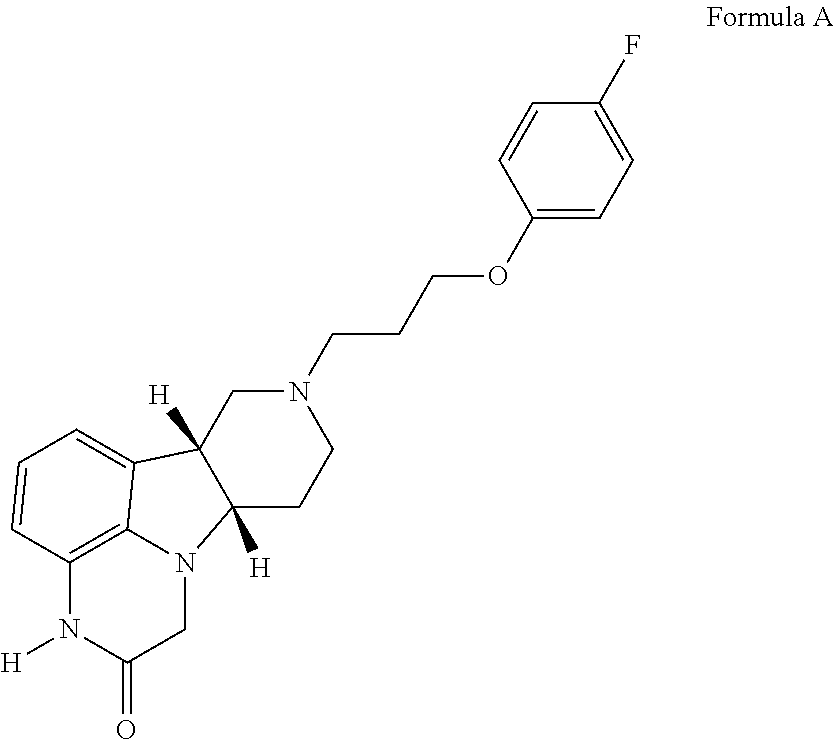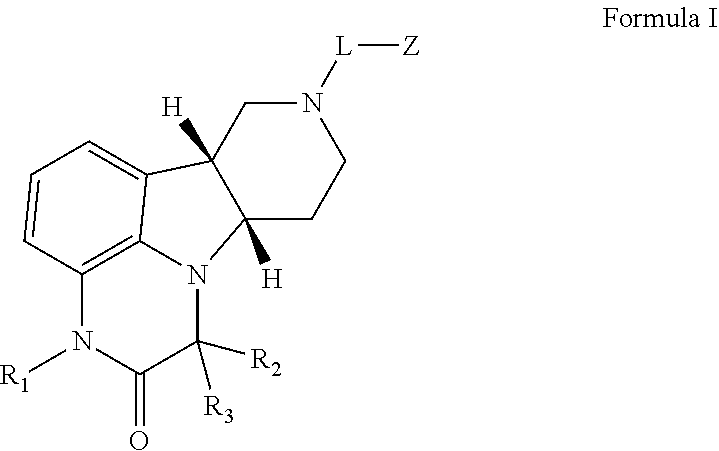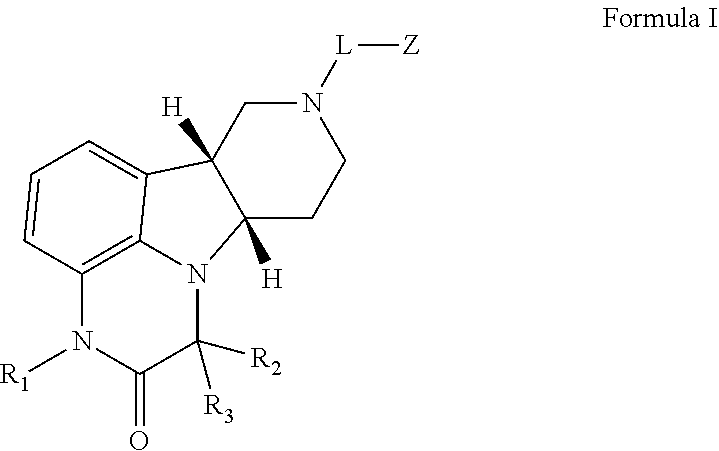Methods of treating addiction
a technology of gammacarbolines and heterocycles, applied in the field of methods of treating addiction, can solve the problems of limited success in treating addiction, disorder which is difficult to successfully treat, and unexpectedly shows significant activity
- Summary
- Abstract
- Description
- Claims
- Application Information
AI Technical Summary
Benefits of technology
Problems solved by technology
Method used
Image
Examples
example 1
of (6bR,10aS)-8-(3-(4-fluorophenoxy)propyl)-6b,7,8,9,10,10a-hexahydro-1H-pyrido[3′,4′:4,5]pyrrolo[1,2,3-de]quinoxalin-2(3H)-one
[0225]
[0226]A mixture of (6bR,10aS)-6b,7,8,9,10,10a-hexahydro- 1H-pyrido[3′,4′:4,5]pyrrolo[1,2,3-de]quinoxalin-2(3H)-one (100 mg, 0.436 mmol), 1-(3-chloroproxy)-4-fluorobenzene (100 μL, 0.65 mmol) and potassium iodide (KI) (144 mg, 0.87 mmol) in dimethylformamide (DMF) (2 mL) is degassed with argon for 3 minutes and N,N-diisopropylethylamine (DIPEA) (150 μL, 0.87 mmol) is added. The resulting mixture is heated to 78° C. and stirred at this temperature for 2 h. The mixture is cooled to room temperature and then filtered. The filter cake is purified by silica gel column chromatography using a gradient of 0-100% ethyl acetate in a mixture of methanol / 7N NH3 in methanol (1:0.1 v / v) as an eluent to produce partially purified product, which is further purified with a semi-preparative HPLC system using a gradient of 0-60% acetonitrile in water containing 0.1% formi...
example 2
of (6bR,10aS)-8-(3-(6-fluoro-1H-indazol-3-yl)propyl)-6b,7,8,9,10,10a-hexahydro-1H-pyrido[3′,4′:4,5]pyrrolo[1,2,3-de]quinoxalin-2(3H)-one
[0227]
[0228]Step 1: To a stirred solution of BC13.MeS (10.8 g, 60 mmol) in toluene at 0-5° C. is added 3-fluoroaniline (5.6 mL, 58 mmol), followed by 4-chlorobutyronitrile (7.12 g. 68.73 mmol) and aluminum chloride (AlCl3) (8.0 g, 60.01 mmol). The mixture is stirred at 130° C. overnight and cooled to 50° C. Hydrochloric acid (3N, 30 mL) is added carefully and the resulting solution is stirred at 90° C. overnight. The obtained brown solution is cooled to room temperature and evaporated to dryness. The residue is dissolved in dichloromethane (DCM) (20 mL) and basified with saturated Na2CO3 to pH=7-8. The organic phase is separated, dried over Na2CO3 and then concentrated. The residue is purified by silica-gel column chromatography using a gradient of 0-20% ethyl acetate in hexane as eluent to afford 2′-amino-4-chloro-4′-fluorobutyrophenone as a yellow...
example 3
of (6bR,10aS)-8-(3-(6-fluorobenzo[d]isoxazol-3-yl)propyl)-6b,7,8,9,10,10a-hexahydro-1H-pyrido[3′,4′:4,5]pyrrolo[1,2,3-de]quinoxalin-2(3H)-one
[0231]
[0232]A mixture of (6bR,10aS)-6b,7,8,9,10,10a-hexahydro- 1H-pyrido[3′,4′:4,5]pyrrolo[1,2,3-de]quinoxalin-2(3H)-one (148 mg, 0.65 mmol), 3-(3-chloropropyl)-6-fluorobenzo[d]isoxazole (276 mg, 1.3 mmol) and KI (210 mg, 1.3 mmol) is degassed with argon and then DIPEA (220 μL, 1.3 mmol) is added. The resulting mixture is stirred at 78° C. for 2 h and then cooled to room temperature. The mixture is concentrated under vacuum. The residue is suspended in dichloromethane (50 mL) and then washed with water (20 mL). The organic phase is dried over K2CO3, filtered, and then concentrated under vacuum. The crude product is purified by silica gel column chromatography with a gradient of 0-10% of methanol in ethyl acetate containing 1% 7N NH3 to yield the title product as a solid (80 mg, yield 30%). MS (ESI) m / z 407.2 [M+1]+. 1H NMR (500 MHz, DMSO-d6) δ ...
PUM
| Property | Measurement | Unit |
|---|---|---|
| of time | aaaaa | aaaaa |
| diameter | aaaaa | aaaaa |
| diameter | aaaaa | aaaaa |
Abstract
Description
Claims
Application Information
 Login to View More
Login to View More - R&D
- Intellectual Property
- Life Sciences
- Materials
- Tech Scout
- Unparalleled Data Quality
- Higher Quality Content
- 60% Fewer Hallucinations
Browse by: Latest US Patents, China's latest patents, Technical Efficacy Thesaurus, Application Domain, Technology Topic, Popular Technical Reports.
© 2025 PatSnap. All rights reserved.Legal|Privacy policy|Modern Slavery Act Transparency Statement|Sitemap|About US| Contact US: help@patsnap.com



